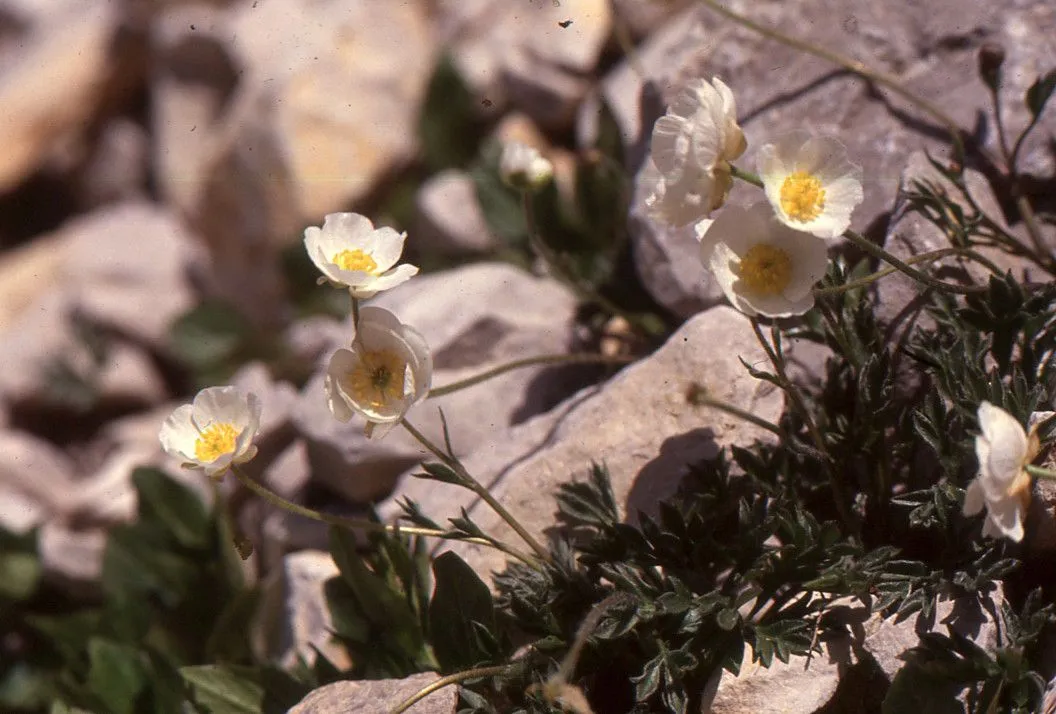
Author: Vill.
Bibliography: Prosp. Hist. Pl. Dauphiné: 50 (1779)
Year: 1779
Status: accepted
Rank: species
Genus: Ranunculus
Vegetable: False
Observations: NW. Spain, Alps, C. Appennini
The Sguier-hahnenfu, scientifically known as Ranunculus seguieri, is a captivating and resilient species belonging to the Ranunculaceae family. Its botanical heritage can be traced back to “Prosp. Hist. Pl. Dauphiné: 50,” penned in 1779 by the renowned botanist Vill.
This perennial herb commands particular interest owing to its geographical diversity and adaptability. It is prevalent in several regions, notably the northwestern areas of Spain, the sprawling landscapes of the Alps, and the central ranges of the Apennines. These varying locales highlight the plant’s versatility and ecological significance, showing how it thrives across different mountainous terrains.
The Sguier-hahnenfu, with its bright, typically yellow blossoms, is not just an aesthetic wonder but also a critical component of its native ecosystems, contributing to the biodiversity and ecological balance of these regions. The plant tends to flourish in well-drained soils and is often found in meadows, rocky slopes, and alpine grasslands, where it receives adequate sunlight and moderate moisture.
Understanding the Sguier-hahnenfu’s environmental role and propagation helps in the conservation efforts crucial for maintaining the natural beauty and biodiversity of our mountainous ecosystems. Its presence in the flora of the regions it inhabits attests to the intricate and delicate web of life where each species, no matter how small, plays a vital part.
Deu: séguier-hahnenfuß
En: Sguier-Hahnenfu, Séguier’s Buttercup
Fr: Renoncule de Séguier
De: Séguier-Hahnenfuß, Séguiers Hahnenfuß
It: Ranuncolo di S√©guier, Ranuncolo di Séguier
: Sguier-hahnenfu
Taken Jun 28, 2014 by Tela Botanica − Geneviève Botti (cc-by-sa)
Taken Jun 19, 2014 by Tela Botanica − Ans GORTER (cc-by-sa)
Taken Jun 30, 1991 by Tela Botanica − Liliane ROUBAUDI (cc-by-sa)
Taken Jun 30, 1991 by Tela Botanica − Liliane ROUBAUDI (cc-by-sa)
Taken Jun 30, 1991 by Tela Botanica − Liliane ROUBAUDI (cc-by-sa)
Taken Jul 15, 2008 by Photoflora – Benoit BOCK (©)
Taken Jul 15, 2007 by Photoflora – Benoit BOCK (©)
Taken Jul 15, 2007 by Photoflora – Benoit BOCK (©)
Taken Jul 15, 2011 by Tela Botanica − Mathieu MENAND (cc-by-sa)
Taken Jul 23, 2017 by Yoan MARTIN (cc-by-sa)
Taken Jun 21, 2017 by Tela Botanica − Jean-Jacques HOUDRÉ (cc-by-sa)
Taken Jun 22, 2014 by Reinhard Bachmann (cc-by-sa)
Taken May 14, 2017 by Yoan MARTIN (cc-by-sa)
Taken Jun 19, 2014 by Tela Botanica − Ans GORTER (cc-by-sa)
Taken Jun 30, 1991 by Tela Botanica − Liliane ROUBAUDI (cc-by-sa)
Taken Jun 11, 2021 by herve (cc-by-sa)
Taken Jun 30, 1991 by Tela Botanica − Liliane ROUBAUDI (cc-by-sa)
Taken Jun 30, 1991 by Tela Botanica − Liliane ROUBAUDI (cc-by-sa)
Taken Jul 15, 1999 by Photoflora – Benoit BOCK (©)
Taken Jul 15, 2007 by Photoflora – Benoit BOCK (©)
Taken Jul 15, 2007 by Photoflora – Benoit BOCK (©)
Taken Jan 1, 1970 by Photoflora – L’Abbé COSTE (©)
Family: Myrtaceae Author: (F.Muell.) K.D.Hill & L.A.S.Johnson Bibliography: Telopea 6: 402 (1995) Year: 1995 Status:…
Family: Rubiaceae Author: Pierre ex A.Froehner Bibliography: Notizbl. Bot. Gart. Berlin-Dahlem 1: 237 (1897) Year:…
Family: Sapindaceae Author: Koidz. Bibliography: J. Coll. Sci. Imp. Univ. Tokyo 32(1): 38 (1911) Year:…
Family: Asteraceae Author: A.Gray Bibliography: Pacif. Railr. Rep.: 107 (1857) Year: 1857 Status: accepted Rank:…
Family: Fabaceae Author: Medik. Bibliography: Vorles. Churpfälz. Phys.-Ökon. Ges. 2: 398 (1787) Year: 1787 Status:…
Family: Aspleniaceae Author: (Cav.) Alston Bibliography: Bull. Misc. Inform. Kew 1932: 309 (1932) Year: 1932…